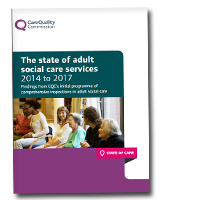The state of adult social care services 2014 to 2017 presents findings from our comprehensive programme of adult social care inspections.

The report looks at what we've found about the quality of care across the full range of adult social care services that we regulate.
What we did
In October 2014, we formally rolled out our new inspection framework for adult social care. It includes overall ratings for each service as well as ratings in each of five key questions – whether they're safe, effective, caring, responsive and well-led.
Between then and February 2017, we've completed over 33,000 inspections of around 24,000 adult social care locations.
We recognise there is fragility in the adult social care sector influenced by funding and resource pressures. But as the quality regulator, our focus in this report is on the quality of adult social care services and the impact that this has on people who use services.
What we found
- At the end of our initial comprehensive inspection programme, almost four out of five adult social care services in England were rated as good or outstanding overall. Nearly a fifth of services were rated as requires improvement. We are particularly concerned about the 343 locations (2%) that were still rated as inadequate.
- We have observed differences in performance from region to region, with the East of England showing almost 10% more locations rated as good or outstanding than the North West.
- Of the five key questions that we asked all services, safe and well-led have the poorest ratings, with around a quarter requires improvement and inadequate.
- Caring was the best rated key question – 92% good and 3% outstanding.
- Community social care services (such as supported living and Shared Lives) were rated the best overall. Nursing homes remain the biggest concern.
- Generally, smaller services that are designed to care for fewer people were rated better than larger services.
- The public values the information in our inspection reports.
Download
The state of adult social care services 2014 to 2017
The state of adult social care services 2014 to 2017 easy read
The state of adult social care services 2014 to 2017: Data appendices
Audio
Join the conversation
Follow #StateofSocialCare on Twitter
Related information
News story: The state of adult social care services 2014 to 2017 report published
Press release: Most services meet the ‘Mum Test’ but there is still too much poor care, finds CQC
Snippet for State of xxx document pages
Findings from our inspection programmes
The state of care in: